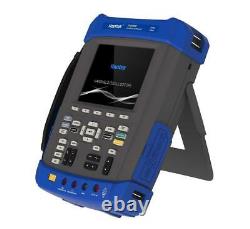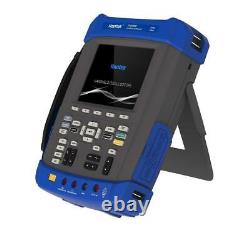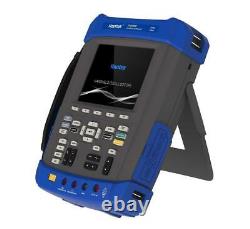
- Index
- Bandwidth
- Brand
- Features
- Model
- 1013d (71)
- 1014d (18)
- 6074bc (52)
- 6104bd (14)
- Digital Oscilloscope (13)
- Ds213 (24)
- Dso2c10 (29)
- Dso2c15 (24)
- Dso2d15 (19)
- Dso4254b (13)
- Dso4254c (18)
- Dso5102p (24)
- Fnirsi-1014d (54)
- Hantek6104bc (21)
- Ht-dso4104c (13)
- Jds2022a (28)
- Oscilloscope (15)
- Storage Oscilloscope (24)
- Vds1022i (22)
- 2230 (17)
- Other (2415)
- Sample Rate
- 00msa / S (3)
- 1 Gsa / S (36)
- 10 Msa / S (4)
- 100 Mhz (3)
- 100 Msa / S (6)
- 100msa / S (6)
- 150msa / S (2)
- 1gs / S (9)
- 1gsa / S (97)
- 2.4msa / S (17)
- 200 Mhz (3)
- 200 Msa / S (7)
- 200msa / S (16)
- 250ms / S (5)
- 250msa / S (4)
- 300msa / S (2)
- 48ms / S (8)
- 500 Msa / S (7)
- 500ms / S (2)
- Less Than 200msa / S (12)
- Other (2679)
- Type
Hantek DSO8102E Handheld Oscilloscope 2M Memory, 6000 Counts DMM+DSO+AFG 100MHZ






Six in one: Oscilloscope/Recorder/DMM/ Spectrum Analyzer/Frequency Counter/Arbitrary Waveform generator. IP-51 rated for dust, drip and shake proof to withstand harsh environments.
Large fuse confirms to European Safety Standard. Battery indicator with easy-changed connect points.
Selectable 18650 battery box for matching 18650 battery by yourself. Anti-theft lock hole, tripod fixed hole, hang rope, FLASH light that can be used in darkness. Replaceable BNC safety joints, and additional one set of joints. 1GSa/s sample rate, 2M Memory depth, 6000 counts DMM. Large 5.6 inch TFT Color LCD Display; High Resolution(640480).High bandwidth 70MHz-200MHz Oscilloscope, 1GSa/s sample rate, 2M Memory depth. Waveform Generator, 200 Mesa/s DDS, 12 bit vertical resolution, easy for simulating transducer. 6000 Counts DMM, AC/DC voltage, AC/DC current, resistance, break, capacitance, and diode function. FFT spectral analysis; Waveform Math: add, subtract, multiply and divide; X-Y mode; more than 20 automatic measurements; PASS/FAIL Check function, apply to engineering application.
Abundant trigger function, double timebase sampling, easy to observe two waveforms in different frequency. Record and replay of more than 1000 waveforms. USB Host/Device 2.0 full-speed interface; support removable disk; WIFI/LAN Option, easy to control by PC or long-distance. Waveform data can be output in WORD, EXCEL, BMP, JPG as time and voltage.
High-frequency and randon glith capture. Wavefom Average, selectable 4,8,16,32,64,128. CAT I and CAT II: 300VRMS (10×), Installation Category.
4ns/div to 8ns/div; (-8div x s/div) to 40ms. S/div to 40s/div;(-8div×s/div) to 400s. Single-shot, Normal mode:± (1 sample interval +100ppm × reading + 0.6ns). >16 averages:± (1 sample interval + 100ppm × reading + 0.4ns). Sample interval = s/div ÷ 200.
8-bit resolution, all channel sampled simultaneously. 2mV/div to 100V/div at input BNC.
Rise Time at BNC(typical). Modes at BNC or with probe. Hanning, Flatop, Rectamgular, Bartlett, Blackman; 1024 sample point.
±3% for Normal or Average acquisition mode, 100V/div to 10mV/div. ±4% for Normal or Average acquisition mode, 5mV/div to 2mV/div. 16 waveforms with vertical position at zero. Accuracy: ± (3% × reading + 0.1div + 1mV) when 10mV/div or greater is selected.
16 waveforms with vertical position not at zero. Accuracy: ± [3% × (reading + vertical position) + 1% of vertical position + 0.2div]. Delta volts between any two averages of? 16 waveforms acquired under same setup and ambient conditions. Edge, Video, Pulse, Slope, Over time, Alternative.DC, AC, HF Reject, LF Reject, Noise Reject. 1div from DC to 10MHz; 1.5div from 10MHz to 100MHz; 2div from 100MHz to Full. AC: Attenuates signals below 10Hz.
HF Reject: Attenuates signals above 80kHz. LF Reject: Same as the DC-coupled limits for frequencies above 150kHz; attenuates signals below 150kHz. CH1/CH2: ±8 divisions from center of screen. Trigger Level Accuracy(typical)Accuracy is for signals having rise and fall times? CH1/CH2: 0.2div × volts/div within ±4 divisions from center of screen. Set Level to 50%(typical). CH1, CH2: Peak-to-peak amplitude of 2 divisions. Signal Formats and Field Rates. Supports NTSC, PAL and SECAM broadcast systems for any field or any line.; Positive pulse or Negative pulse. Equal: The oscilloscope triggers when the trailing edge of the pulse crosses the trigger level. Not Equal: If the pulse is narrower than the specified width, the trigger point is the trailing edge. Otherwise, the oscilloscope triggers when a pulse continues longer than the time specified as the Pulse Width.
Less than: The trigger point is the trailing edge. Greater than (also called overtime trigger): The oscilloscope triggers when a pulse continues longer than the time specified as the Pulse Width. ; Positive slope or Negative slope.
Equal: The oscilloscope triggers when the waveform slope is equal to the set slope. Not Equal: The oscilloscope triggers when the waveform slope is not equal to the set slope. Less than: The oscilloscope triggers when the waveform slope is less than the set slope. Greater than: The oscilloscope triggers when the waveform slope is greater than the set slope. Rising edge or Falling edge. Internal Trigger: Edge, Pulse Width, Video, Slope. ±30ppm (including all frequency reference errors and ±1 count errors). AC coupled, from 4Hz minimum to rated bandwidth. Pulse Width or Edge Trigger modes: all available trigger sources. The Frequency Counter measures trigger source at all times, including when the oscilloscope acquisition pauses due to changes in the run status, or acquisition of a single shot event has completed. Pulse Width Trigger mode: The oscilloscope counts pulses of significant magnitude inside the 1s measurement window that qualify as triggerable events, such as narrow pulses in a PWM pulse train if set to. Edge Trigger mode: The oscilloscope counts all edges of sufficient magnitude and correct polarity. Video Trigger mode: The Frequency Counter does not work. Manual: Voltage difference between cursors. Tracing: The valtage and time at a waveform point. Frequency, Period, Mean, Pk-Pk, Cycli RMS, Minimum, Maximum, Rise time, Fall Time, +Pulse Width, -Pulse Width, Delay1-2Rise, Delay1-2Fall, +Duty, -Duty, Vbase, Vtop, Vmid, Vamp, Overshoot, Preshoot, Preiod Mean, Preiod RMS. 640 horizontal by 480 vertical pixels. Adjustable (16 gears) with the progress bar. AC Input:100-240VACRMS, 0.6A MAX, 50Hz60Hz; DC Output:9V, 2A.Operating: Below 3,000m (10,000 feet). Nonoperaring: Below 15,000m(50,000 feet). Voltage, Current, Resistance, Capacitance, Diode & Continuity.
Attention: the smallest capacitance value that can be measured in 5nF. The standard package don't include batteries.
If you have any questions or comments whatsoever regarding our products or listing, we are waiting to hear from you. If the product malfunctioned under proper usage per instructions.
30 days evaluation and investigation takes placed after receiving your return item.

